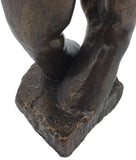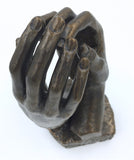Rodin Cathedral Clasping Hands Gesture of Togetherness Statue Small 6H
PN# RO26In this sculptural study of two hands preparing to clasp, Rodin has taken interest in the shape formed by these two hands creating a "Cathedral" or pitched roof line. Small (RO26) - 7 in H x 3.5 in W x 3 in D. Weighs 2 lbs.
Considered to be one of the greatest sculptors of all time, Auguste Rodin's artworks are characterized by his deft modeling of the human form in a semi-impressionistic, semi-realistic image. It is structural and physical as well as spiritual and transcendent. Reproduced after an original from the late 19th century, Rodin enchants us with the magical anticipation of these two hands about to clasp.
- Bronze like finish over resin.
- Rodin's signature is reproduced on one corner.
- Part of the museum reproduction collection by Parastone of Europe.
- Small (RO26) - 7 in H x 3.5 in W x 3 in D. Weighs 2 lbs.
About Auguste Rodin (1840-1917):
For a long time the life of the sculptor Rodin was marked by the mixed reactions his work provoked with the audience. The lack of understanding for Rodin's work was partly due to the original character of his art. He felt little for the strict formats of Romanticism and neither did he want to identify himself with the neutrality of the Impressionist. Rodin's work is characterized by a passion for the human body and he considered himself incapable of any creativity if he did not have a living model in front of him. "In everything I follow nature and I never pretend I am able to control her. My only ambition is to be subservient and faithful to her," he said. Questions about his often controversial, erotic works were answered with the remark "Art is actually nothing more than a manifestation of lust, which only arises from the potency to love."
Rodin's life upheld this belief with a vast succession of lovers having passed his artistic eye. Many affairs were brief, but one of them turned out to be of enormous value to his later work: Camille Claudel. This self-willed, fierce woman, who was very talented sculptor herself, inspired him to create his most famous and admired sculptures. The affair continued for a long time, although Camille had to put up with Rodin's numerous escapades and his loyal companion Rose Beuret. Eventually, the affair ended and Camille suffered the dramatic consequences of this split. She became isolated and confused and in the end she was forced by her family to have herself admitted to a psychiatric hospital.
Towards the end of his life, Rodin could look back upon a successful artistic career. He had given his works to the French government, which had in turn promised to found a museum in his name. Rodin was buried with full honors and the words his father had once spoken turned out to be prophetic: "The day will come that will say about you, what they say about all truly great men: the artist Auguste Rodin is dead, but he lives on for our descendants, for the future."













